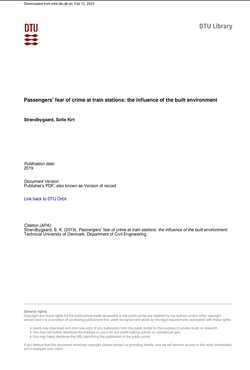By Sofie Kirt Strandbygaard
The objective of this thesis is to explore passengers’ experience of fear of crime at S-train stations and the possible relation to the stations’ surrounding environments. The thesis consists of three articles each exploring different layers of the research with the aim of unfolding train passengers’ fear of crime in relation to the built environment. The analysis is based on case studies of 84 S-train stations and their neighbourhoods in the Copenhagen metropolitan area. The S-train is the local rail network in the regional development plan, the Finger Plan. The method of analysis is typomorphological, defining urban types based on their patterns and spatial characteristics. Because the focus is passengers’ experience of fear of crime in public space the spatial analysis is guided by Crime Prevention Through Environmental Design principles. The analysis outlines three main station neighbourhood types and several subcategories of combinations between the three. When compared with passenger surveys of fear of crime at the S-train train stations, the results exhibit a relationship between the types of station neighbourhood form and passengers’ fear of crime at the associated station. When comparing station neighbourhood form with income, the results show that fear of crime at stations is strongly correlated with low income in the station’s neighbourhood. However, a significant research result is that when adjusting for income, passengers’ experience of fear of crime still follows the same type of neighbourhood form. This result underlines the influence of urban spatial characteristics on passengers’ experience of fear of crime. An analysis of thirteen representative S-train stations and their vicinities according to international design guidelines for transit-oriented development (TOD) is performed to look at the urban space surrounding the stations. The analysis reveals that the Finger Plan is a regional public transport-oriented development, however, several of the stations’ surrounding urban areas show a prevailing tendency to neglect the pedestrian design scale and design dimensions related to safety. The thesis’ research results provide knowledge on passengers’ experience of stations. It contributes with perspectives on and insights into S-train stations and their neighbourhoods in Copenhagen and can assist the transport industry in improving passengers’ experience of train stations. Contributions from the research is a CPTED design analysis tool for public transport environments and recommendations for Danish TOD practice. The thesis contributes with novel research results to the existing international body of knowledge on passengers’ fear of crime at train stations.
Lyngby. Denmark: Department of Civil Engineering Technical University of Denmark. 2019. 206p.


